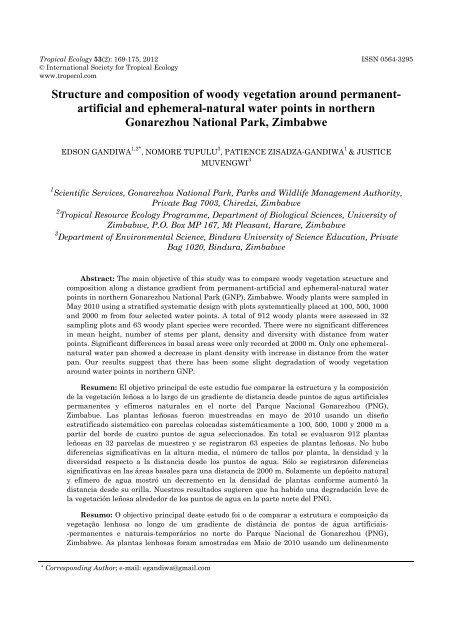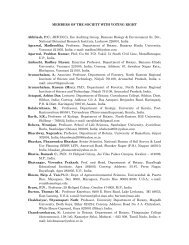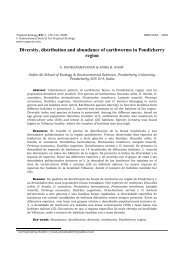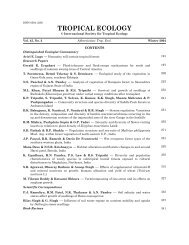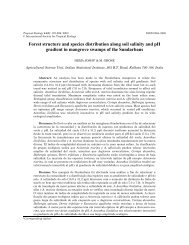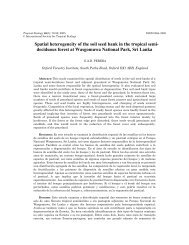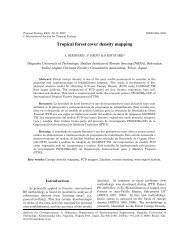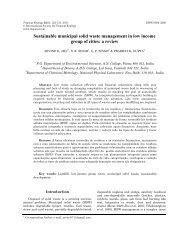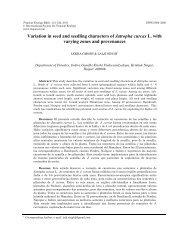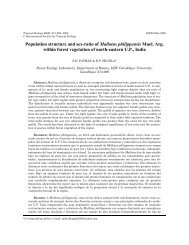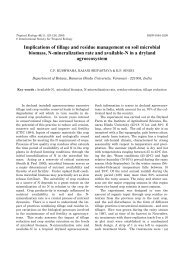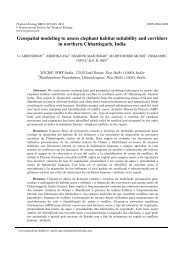Structure and composition of woody vegetation around permanent ...
Structure and composition of woody vegetation around permanent ...
Structure and composition of woody vegetation around permanent ...
You also want an ePaper? Increase the reach of your titles
YUMPU automatically turns print PDFs into web optimized ePapers that Google loves.
Tropical Ecology 53(2): 169-175, 2012 ISSN 0564-3295© International Society for Tropical Ecologywww.tropecol.com<strong>Structure</strong> <strong>and</strong> <strong>composition</strong> <strong>of</strong> <strong>woody</strong> <strong>vegetation</strong> <strong>around</strong> <strong>permanent</strong>artificial<strong>and</strong> ephemeral-natural water points in northernGonarezhou National Park, ZimbabweEDSON GANDIWA 1,2* , NOMORE TUPULU 3 , PATIENCE ZISADZA-GANDIWA 1 & JUSTICEMUVENGWI 31 Scientific Services, Gonarezhou National Park, Parks <strong>and</strong> Wildlife Management Authority,Private Bag 7003, Chiredzi, Zimbabwe2 Tropical Resource Ecology Programme, Department <strong>of</strong> Biological Sciences, University <strong>of</strong>Zimbabwe, P.O. Box MP 167, Mt Pleasant, Harare, Zimbabwe3 Department <strong>of</strong> Environmental Science, Bindura University <strong>of</strong> Science Education, PrivateBag 1020, Bindura, ZimbabweAbstract: The main objective <strong>of</strong> this study was to compare <strong>woody</strong> <strong>vegetation</strong> structure <strong>and</strong><strong>composition</strong> along a distance gradient from <strong>permanent</strong>-artificial <strong>and</strong> ephemeral-natural waterpoints in northern Gonarezhou National Park (GNP), Zimbabwe. Woody plants were sampled inMay 2010 using a stratified systematic design with plots systematically placed at 100, 500, 1000<strong>and</strong> 2000 m from four selected water points. A total <strong>of</strong> 912 <strong>woody</strong> plants were assessed in 32sampling plots <strong>and</strong> 63 <strong>woody</strong> plant species were recorded. There were no significant differencesin mean height, number <strong>of</strong> stems per plant, density <strong>and</strong> diversity with distance from waterpoints. Significant differences in basal areas were only recorded at 2000 m. Only one ephemeralnaturalwater pan showed a decrease in plant density with increase in distance from the waterpan. Our results suggest that there has been some slight degradation <strong>of</strong> <strong>woody</strong> <strong>vegetation</strong><strong>around</strong> water points in northern GNP.Resumen: El objetivo principal de este estudio fue comparar la estructura y la composiciónde la vegetación leñosa a lo largo de un gradiente de distancia desde puntos de agua artificiales<strong>permanent</strong>es y efímeros naturales en el norte del Parque Nacional Gonarezhou (PNG),Zimbabue. Las plantas leñosas fueron muestreadas en mayo de 2010 us<strong>and</strong>o un diseñoestratificado sistemático con parcelas colocadas sistemáticamente a 100, 500, 1000 y 2000 m apartir del borde de cuatro puntos de agua seleccionados. En total se evaluaron 912 plantasleñosas en 32 parcelas de muestreo y se registraron 63 especies de plantas leñosas. No hubodiferencias significativas en la altura media, el número de tallos por planta, la densidad y ladiversidad respecto a la distancia desde los puntos de agua. Sólo se registraron diferenciassignificativas en las áreas basales para una distancia de 2000 m. Solamente un depósito naturaly efímero de agua mostró un decremento en la densidad de plantas conforme aumentó ladistancia desde su orilla. Nuestros resultados sugieren que ha habido una degradación leve dela vegetación leñosa alrededor de los puntos de agua en la parte norte del PNG.Resumo: O objectivo principal deste estudo foi o de comparar a estrutura e composição davegetação lenhosa ao longo de um gradiente de distância de pontos de água artificiais--<strong>permanent</strong>es e naturais-temporários no norte do Parque Nacional de Gonarezhou (PNG),Zimbabwe. As plantas lenhosas foram amostradas em Maio de 2010 us<strong>and</strong>o um delineamento* Corresponding Author; e-mail: eg<strong>and</strong>iwa@gmail.com
170 WOODY VEGETATION AROUND WATER POINTSestratificado sistemático colocado a 100, 500, 1000 e 2000 metros de quatro pontos de águaselecionados. Foram avaliadas um total de 912 plantas lenhosas em 32 talhões amostra, tendosido registadas 63 espécies de plantas lenhosas. Não foram encontradas diferenças significativasquanto à altura média, número de troncos por plantas, densidade e diversidade com a distânciaentre os pontos de água. Só a 2000 m foram registadas diferenças significativas nas áreasbasais. Só num ponto de água temporário se verificou um decréscimo na densidade das plantascom o aumento de distância à poça de água. Os nossos resultados sugerem que tem havido umaligeira degradação da vegetação lenhosa à volta dos pontos de água na zona norte do PNG.Key words: Benji dam, browsing, Massasanya dam, piosphere, savanna.Savannas are characterised by the co-existence<strong>of</strong> a herb layer, dominated by C4 grasses, <strong>and</strong>variable densities <strong>of</strong> trees <strong>and</strong> shrubs, whose proportionsare influenced by water availability,nutrients, fire <strong>and</strong> herbivores (Scholes & Archer1997). Vegetation gradients developing <strong>around</strong>water sources (i.e. piospheres) are importantfeatures <strong>of</strong> arid <strong>and</strong> semi-arid ecosystems (Lange1969). Studied extensively in pastoral areas (e.g.Andrew 1988; James et al. 1999; Todd 2006),piospheres are also increasingly being investigatedin areas hosting rich herbivore diversity (e.g.Chamaillé-James et al. 2009; Gaugris & VanRooyen 2009; Makhabu et al. 2002; Parker &Witkowski 1999; Thrash 1998; Thrash et al. 1991).Here we aim to contribute to the underst<strong>and</strong>ing <strong>of</strong><strong>woody</strong> <strong>vegetation</strong> structure <strong>and</strong> <strong>composition</strong> inwoodl<strong>and</strong>s <strong>around</strong> water points in northernGonarezhou National Park (GNP), Zimbabwe. Themain objective <strong>of</strong> the present study was to comparedensity, height, number <strong>of</strong> stems per plant, basalarea <strong>and</strong> species diversity <strong>of</strong> <strong>woody</strong> <strong>vegetation</strong>with distance from <strong>permanent</strong>-artificial <strong>and</strong>ephemeral-natural water points in northern GNP.Established in the early 1930s as a GameReserve, GNP was upgraded into a nationalpark under the Parks <strong>and</strong> Wildlife Act <strong>of</strong> 1975.GNP has been part <strong>of</strong> the Great LimpopoTransfrontier Park since 2000. Covering an area <strong>of</strong>5,053 km 2 , GNP is located in southeast Zimbabwe,between 21° 00' - 22° 15' S <strong>and</strong> 30° 15' - 32° 30' E.Altitude varies between 165 <strong>and</strong> 575 m above sealevel. GNP experiences two seasons, a wet season<strong>and</strong> a dry season, which are very contrasting.Annual average rainfall is about 466 mm, withOctober to March being the wettest months. Thedry season normally lasts from April to September.Average monthly maximum temperatures are25.9 °C in July <strong>and</strong> 36 °C in January. Averagemonthly minimum temperatures range between9 °C in June <strong>and</strong> 24 °C in January (G<strong>and</strong>iwa &Kativu 2009). The entire GNP constitutes thecatchments <strong>of</strong> the Guluene, Chefu, Save, Runde<strong>and</strong> Mwenezi rivers. The river courses constitutespecial habitats in their riverine <strong>vegetation</strong>, surfacewaters <strong>and</strong> floodplain. Other natural waterresources in GNP are the seasonal pans, whichhold water to varying durations into the dryseason (Tafangenyasha 1997a). A perception hasbeen that greater use <strong>of</strong> the GNP could be made bythe introduction <strong>of</strong> artificial water at strategicpoints, thus dispersing the game over a wider area(Tafangenyasha 1997b). To this effect, two dams(Benji <strong>and</strong> Massassanya) were constructed in the1970s. The major <strong>vegetation</strong> type is mopane(Colophospermum mopane [Kirk ex Benth.] Kirk exJ. Léonard) woodl<strong>and</strong>, which covers approximately40 % <strong>of</strong> GNP. There is a wide variety <strong>of</strong> largeherbivore species in GNP ecosystem <strong>and</strong> theseinclude African buffalo (Syncerus caffer Sparrman,1779), giraffe (Giraffa camelopardalis Linnaeus,1758), waterbuck (Kobus ellipsiprymnus Ogilby,1833), kudu (Tragelaphus strepsiceros Pallas,1766), Burchell’s zebra (Equus burchelli Gray,1824), wildebeest (Connochaetes taurinus Burchell,1823), African elephant (Loxodonta africanaBlumenbach, 1797) <strong>and</strong> hippopotamus (Hippopotamusamphibius Linnaeus, 1758). The park hasa variety <strong>of</strong> large carnivores such as lion (Pantheraleo Linnaeus, 1758) <strong>and</strong> spotted hyena (Crocutacrocuta Erxleben, 1777).A stratified systematic sampling procedurewas adopted in this study. We selected four waterpoints, two <strong>permanent</strong>-artificial (i.e. Benji <strong>and</strong>Massasanya dams) <strong>and</strong> two ephemeral-naturalwater points (i.e. Chidhlambani <strong>and</strong> Urombo pans).The ephemeral water points used in this studyhave similar characteristics. Both are natural pans
GANDIWA et al. 171<strong>and</strong> generally retain water for almost similarperiods. Selected water points in this studyoccurred in mopane, Lebombo ironwood (Androstachysjohnsonii Prain), red bushwillow (Combretumapiculatum Sond.) <strong>and</strong> tamboti (Spirostachysafricana Sonder) mixed woodl<strong>and</strong>s. The development<strong>of</strong> sampling technique used in this studyfollowed that <strong>of</strong> Brits et al. (2002). At each selectedwater point, two line transects, each 2 km weretraversed. Direction <strong>of</strong> each line transect from thewater point was determined through a r<strong>and</strong>omizationprocedure, using a r<strong>and</strong>om number table.R<strong>and</strong>om numbers were used as angles thatindicated the direction <strong>of</strong> the line transect from thetrue North. A plot size <strong>of</strong> 20 × 50 m was used inthis study. This plot size was determined followingWalker’s (1976) method <strong>of</strong> having at least 15 to 20trees <strong>of</strong> the dominant <strong>vegetation</strong> inside a plot. Twoplots were systematically placed at 100, 500, 1000<strong>and</strong> 2000 m distances along each line transectfrom each water point. This gave a total <strong>of</strong> eightplots for each water point.Floristic <strong>composition</strong> <strong>and</strong> structure <strong>of</strong> <strong>woody</strong><strong>vegetation</strong> component were assessed in May 2010.At this time <strong>of</strong> the year, species <strong>composition</strong> ismost conspicuous. In each sample plot, the followingvariables were recorded or measured: tree height,stem circumference, <strong>woody</strong> <strong>vegetation</strong> species <strong>and</strong>number <strong>of</strong> stems per plant. Trees were defined as<strong>woody</strong> plants greater than 3 m in height <strong>and</strong>greater than 6 cm basal diameter, above buttressswelling (Ben-Shahar 1998). All <strong>woody</strong> plantsrooted within a plot were recorded <strong>and</strong> measured.Woody plants occurring along plot margins wereincluded if at least half <strong>of</strong> the rooted system wasinside the plot (Walker 1976). For multi-stemmedplants located at edges <strong>of</strong> plots, only stems withmore than half their base inside the plot weremeasured <strong>and</strong> recorded. Data collection proceduresused in this study followed those outlined byG<strong>and</strong>iwa & Kativu (2009).We conducted statistical tests using STATIS-TICA for Windows, version 6 (StatS<strong>of</strong>t 2001).Vegetation survey data were tested for normalityusing the Shapiro-Wilk test (Shapiro & Wilk 1965)<strong>and</strong> were found to be normal. In order to testwhether there were differences in <strong>vegetation</strong>structure between water points at selecteddistances, we performed one-way ANOVA tests.Significant effects were further analyzed using theFisher’s Least Significant Difference (LSD) posthoctests to detect significant differences betweenwater points. Further, we performed simple linearregression analyses in order to determine therelationship between <strong>woody</strong> <strong>vegetation</strong> variables<strong>and</strong> distance from each water point. For regressionanalyses, distances from water points were takenas the independent variable <strong>and</strong> <strong>woody</strong> <strong>vegetation</strong>variables as the dependent variables. We consideredto be no significance when the value <strong>of</strong> theprobability <strong>of</strong> significance (P) was greater than0.05.A total <strong>of</strong> 912 <strong>woody</strong> plants were assessed inthe 32 sampling plots <strong>and</strong> 63 <strong>woody</strong> plant specieswere recorded. There were no significant differencesin: (1) mean height at 100 (F3,4 = 2.88; P >0.05), 500 (F3,4 = 2.06; P > 0.05), 1,000 (F3,4 = 3.41;P > 0.05) <strong>and</strong> 2,000 (F3,4 = 2.26; P > 0.05) mbetween <strong>permanent</strong>-artificial <strong>and</strong> ephemeralnaturalwater points in northern GNP (Table 1);(2) no significant differences were recorded in themean number <strong>of</strong> stems per plant at 100 (F3,4 =0.370; P > 0.05), 500 (F3,4 = 2.980; P > 0.05), 1,000(F3,4 = 0.438; P > 0.05) <strong>and</strong> 2,000 (F3,4 = 0.919; P >0.05) m; (3) similarly, no significant differenceswere recorded in mean basal area at 100 (F3,4 =1.186; P > 0.05), 500 (F3,4 = 0.616; P > 0.05) <strong>and</strong>1,000 (F3,4 = 5.955; P > 0.05) m; in contrast, therewere significant differences in mean basal areas at2,000 m from the water points (F3,4 = 18.636; P =0.008); LSD post-hoc for basal areas Chidhlambanivs. Massasanya (P < 0.01), Urombo vs. Massasanya(P < 0.05) <strong>and</strong> Benji vs. Massasanya P 0.05), 500(F3,4 = 0.56; P > 0.05), 1,000 (F3,4 = 3.04; P > 0.05)<strong>and</strong> 2,000 (F3,4 = 0.51; P > 0.05) m; <strong>and</strong> (5) meanspecies diversity between <strong>permanent</strong>-artificial <strong>and</strong>ephemeral-natural water points did not differsignificantly at 100 (F3,4 = 3.89; P > 0.05), 500 (F3,4= 1.30; P > 0.05), 1,000 (F3,4 = 2.50; P > 0.05) <strong>and</strong>2,000 (F3,4 = 4.15; P > 0.05) m. With the exception<strong>of</strong> mean density <strong>of</strong> <strong>woody</strong> <strong>vegetation</strong> in the Chidhlambanipan, which decreased with increasingdistance from the water point (R 2 = 0.97; y =480.24 - 0.04x; F1,2 = 56.33; P = 0.017), there wereno other significant relationship between distance<strong>and</strong> structural <strong>and</strong> <strong>composition</strong>al variables <strong>of</strong><strong>woody</strong> <strong>vegetation</strong> in the four sampled water points(Table 1).Our results suggest that <strong>permanent</strong>-artificial<strong>and</strong> ephemeral-natural water points in northernGNP have led to a slight degradation <strong>of</strong> <strong>woody</strong><strong>vegetation</strong> structure adjacent to the water points.We only recorded changes in tree density <strong>and</strong>basal area with distance from water points, despitethe increasing elephant population in GNP. Theelephant population in GNP was first estimated at
172 WOODY VEGETATION AROUND WATER POINTS
GANDIWA et al. 1733,100 in 1969. Recently, the elephant populationwas estimated at 9,100 in GNP during 2009 with adensity <strong>of</strong> 1.84 per km 2 (Dunham et al. 2010). Theexistence <strong>of</strong> two major natural <strong>and</strong> perennialrivers in northern GNP, i.e. the Runde <strong>and</strong> Saverivers could also have an influence on habitat useby herbivores. The distances from the studiedwater points to the two major rivers in northernGNP are relatively small. Therefore, it is possiblethat most animals concentrate more on themajor rivers as compared to the inl<strong>and</strong> waterpoints.An earlier study by Bromwich (1972) foundthat the effect <strong>of</strong> large herbivores on naturalwatering point in GNP may be one <strong>of</strong> utilizationrather than destruction, <strong>and</strong> <strong>woody</strong> <strong>vegetation</strong>may be utilized evenly with distance from water.Elsewhere, a recent study by Kalwij et al. (2010)reported an increase in tree density, canopy cover,<strong>and</strong> volume in central Chobe, Botswana, in spite <strong>of</strong>a growing elephant population. Another study byMakhabu et al. (2002) recorded no severe degradation<strong>of</strong> habitat <strong>around</strong> water points in CentralKalahari Game Reserve <strong>of</strong> Botswana.Our findings are to a lesser extent consistentwith the general assumption that water provisionleads to the degradation <strong>of</strong> woodl<strong>and</strong> structure inthe influence range <strong>of</strong> water points or piospheresas a result <strong>of</strong> trampling <strong>and</strong> increased herbivory bylarge herbivores. Elsewhere, Brits et al. (2002)found a significant, though weak linear relationshipbetween <strong>woody</strong> plant density <strong>and</strong> distancefrom watering point in the neighboring KrugerNational Park, South Africa. Chamaillé-James etal. (2009) reported that <strong>woody</strong> cover was stronglyaffected within the first 2 km <strong>of</strong> the piospheres inHwange National Park, Zimbabwe. Gaugris & VanRooyen (2009) recorded a gradient <strong>of</strong> utilizationaway from <strong>permanent</strong> water in the TembeElephant Park, Maputal<strong>and</strong>, South Africa. Surfacewater availability has a strong influence onelephant movements at the habitat <strong>and</strong> l<strong>and</strong>scapescale (Shannon et al. 2009). The greatest damage<strong>of</strong> the habitat by elephants is in the vicinity <strong>of</strong>rivers <strong>and</strong> <strong>permanent</strong> watering points (Laws1970). It has been suggested that the aggregativeresponse by elephants, <strong>and</strong> other smaller herbivores,<strong>around</strong> water points in the dry seasonresults in increased browsing pressure <strong>and</strong> severetrampling <strong>around</strong> those areas, suppressing theregeneration <strong>of</strong> seedlings <strong>and</strong> shoot growth(Thrash & Derry 1999).Other factors that may affect savannawoodl<strong>and</strong> structure <strong>and</strong> <strong>composition</strong> are droughts,frost, fire, disease, herbivores, edaphic factors,topography <strong>and</strong> past human activities (e.g.Chafota & Owen-Smith 2009; Guldemond & VanAarde 2008). These factors may be interrelated,<strong>and</strong> when they occur simultaneously they,probably, act in concert to exert a stronger effect.Fire frequency is usually low <strong>around</strong> wateringpoints due to high browsing pressure <strong>and</strong> severetrampling by large herbivores, which reduces fuelloads. In northern Chobe National Park, Botswana,elephant browsing was high <strong>and</strong> fire occurrencelow within 2 km from Chobe River <strong>and</strong> browsingwas low <strong>and</strong> fire occurrence high beyond 7 kmfrom the river (Mosugelo et al. 2002). Fire <strong>and</strong>herbivory are events that can interact <strong>and</strong> theconsequences are not always easy to predict (Frostet al. 1986). In GNP, earlier studies havesuggested that fire <strong>and</strong> elephant damagecontributed to the general modification <strong>of</strong> habitats,leading to the decline <strong>of</strong> canopy woodl<strong>and</strong>s <strong>and</strong>herbaceous plant cover in some habitats (G<strong>and</strong>iwa& Kativu 2009; Tafangenyasha 1997a, 2001).Therefore, we recommend that continuedmonitoring using photopanoramas at water pointsshould be given priority, <strong>and</strong> that future researchshould investigate the impact <strong>of</strong> herbivores <strong>around</strong>watering points on specific woodl<strong>and</strong>s in GNP.AcknowledgementsOur thanks go to V. Chadenga, the Director-General <strong>of</strong> Zimbabwe Parks <strong>and</strong> Wildlife ManagementAuthority <strong>and</strong> Dr. H. Madzik<strong>and</strong>a, ChiefEcologist, for permission to undertake this study<strong>and</strong> publish this manuscript. We wish to thank G.Chikorowondo, W. Matsvayi, J. Shimbani, E.Mungoni, D. Sithole, P. Mhaka, T. N. Gotosa, Dr.N. Monks <strong>and</strong> staff <strong>of</strong> Gonarezhou National Parkfor rendering invaluable assistance during thestudy. The manuscript benefited from commentsmade by Dr. Demel Teketay Fanta <strong>and</strong> ananonymous reviewer. The study was made possiblewith support from Frankfurt Zoological Society<strong>and</strong> Zimbabwe Parks <strong>and</strong> Wildlife ManagementAuthority.ReferencesAndrew, M. H. 1988. Grazing impact in relation tolivestock watering points. Trends in Ecology <strong>and</strong>Evolution 3: 336-339.Ben-Shahar, R. 1998. Changes in structure <strong>of</strong> savannawoodl<strong>and</strong>s in northern Botswana following theimpacts <strong>of</strong> elephants <strong>and</strong> fire. Plant Ecology 136:
174 WOODY VEGETATION AROUND WATER POINTS189-194.Brits, J., M. W. Van Rooyen & N. Van Rooyen. 2002.Ecological impact <strong>of</strong> large herbivores on the <strong>woody</strong><strong>vegetation</strong> at selected watering points on theeastern basaltic soils in the Kruger National Park.African Journal <strong>of</strong> Ecology 40: 53-60.Bromwich, M. C. 1972. The Effect <strong>of</strong> IntroducingPermanent Water into a Seasonal Pan on Game <strong>and</strong>Vegetation. Unpublished Certificate Report. University<strong>of</strong> Rhodesia, Salisbury.Chafota, J. & N. Owen-Smith. 2009. Episodic severedamage to canopy trees by elephants: interactionswith fire, frost <strong>and</strong> rain. Journal <strong>of</strong> Tropical Ecology25: 341-345.Chamaillé-Jammes, S., H. Fritz & H. Madzik<strong>and</strong>a. 2009.Piosphere contribution to l<strong>and</strong>scape heterogeneity: acase study <strong>of</strong> remote-sensed <strong>woody</strong> cover in a highelephant density l<strong>and</strong>scape. Ecography 32: 871- 880.Dunham, K. M., E. Van der Westhuizen, H. F. Van derWesthuizen & E. G<strong>and</strong>iwa. 2010. Aerial Survey <strong>of</strong>Elephants <strong>and</strong> Other Large Herbivores in GonarezhouNational Park (Zimbabwe), Zinave National Park(Mozambique) <strong>and</strong> Surrounds: 2009. Parks <strong>and</strong>Wildlife Management Authority, Harare.Frost, P., E. Medina, J. C. Menaut, O. Solbrig, M. Swift& B. Walker. 1986. Responses <strong>of</strong> Savannas to Stress<strong>and</strong> Disturbance: A Proposal for a CollaborativeProgramme <strong>of</strong> Research. The International Union <strong>of</strong>Biological Sciences News Magazine. Special issue10, Harare.G<strong>and</strong>iwa, E. & S. Kativu. 2009. Influence <strong>of</strong> firefrequency on Colophospermum mopane <strong>and</strong> Combretumapiculatum woodl<strong>and</strong> structure <strong>and</strong> <strong>composition</strong>in northern Gonarezhou National Park,Zimbabwe. Koedoe 51(1): Art. #685, 13 pages. DOI:10.4102/koedoe. v51i1.685.Gaugris, J. Y. & M. W. Van Rooyen. 2009. Effects <strong>of</strong>water dependence on the utilization pattern <strong>of</strong><strong>woody</strong> <strong>vegetation</strong> by elephants in the TembeElephant Park, Maputal<strong>and</strong>, South Africa. AfricanJournal <strong>of</strong> Ecology 48: 126-134.Guldemond, R. & R. J. Van Aarde. 2008. A metaanalysis <strong>of</strong> the impact <strong>of</strong> African elephants onsavanna <strong>vegetation</strong>. Journal <strong>of</strong> Wildlife Management72: 892-899.James, C. D., J. L<strong>and</strong>sberg & S. R. Morton. 1999.Provision <strong>of</strong> watering points in the Australian aridzone: a review <strong>of</strong> effects on biota. Journal <strong>of</strong> AridEnvironments 41: 87-121.Kalwij, J. M., W. F. De Boer, L. Mucina, H. H. T. Prins,C. Skarpe & C. Winterbach. 2010. Tree cover <strong>and</strong>biomass increase in a southern African savannadespite growing elephant population. EcologicalApplications 20: 222-233.Lange, R. T. 1969. The piosphere: sheep track <strong>and</strong> dungpatterns. Journal <strong>of</strong> Range Management 22: 396-400.Laws, R. M. 1970. Elephants as agents <strong>of</strong> habitat <strong>and</strong>l<strong>and</strong>scape change in East Africa. Oikos 21: 1-15.Makhabu, S. W., B. Marotsi & J. Perkins. 2002.Vegetation gradients <strong>around</strong> artificial water pointsin the Central Kalahari Game Reserve <strong>of</strong> Botswana.African Journal <strong>of</strong> Ecology 40: 103-109.Mosugelo, D. K., S. R. Moe, S. Ringrose & C. Nellemann.2002. Vegetation changes during a 36-year period innorthern Chobe National Park, Botswana. AfricanJournal <strong>of</strong> Ecology 40: 232-240.Parker, A. H. & E. T. F. Witkowski. 1999. Long-termimpacts <strong>of</strong> abundant perennial water provision forgame on herbaceous <strong>vegetation</strong> in a semi-aridAfrican savanna woodl<strong>and</strong>. Journal <strong>of</strong> Arid Environments41: 309-321.Scholes, R. J. & S. R. Archer. 1997. Tree-grass interactionsin savannas. Annual Review <strong>of</strong> Ecology <strong>and</strong>Systematics 28: 517-544.Shannon, G., W. S. Matthews, B. R. Page, G. E. Parker& R. J. Smith. 2009. The affects <strong>of</strong> artificial wateravailability on large herbivore ranging patterns insavanna habitats: a new approach based onmodelling elephant path distributions. Diversity <strong>and</strong>Distributions 15: 776-783.Shapiro, S. S. & M. B. Wilk. 1965. An analysis <strong>of</strong>variance for normality (complete samples). Biometrika52: 591-611.StatS<strong>of</strong>t. 2001. STATISTICA for Windows, Version 6.2300. StatS<strong>of</strong>t, Tulsa.Tafangenyasha, C. 1997a. Tree loss in GonarezhouNational Park (Zimbabwe) between 1970 <strong>and</strong> 1983.Journal <strong>of</strong> Environmental Management 49: 355-366.Tafangenyasha, C. 1997b. Should Benji Dam be dredged?A preliminary impact assessment to dredging awater reservoir in an African national park. TheEnvironmentalist 17: 191-195.Tafangenyasha, C. 2001. Decline <strong>of</strong> the mountain acacia,Brachystegia glaucescens, in Gonarezhou NationalPark, southeast Zimbabwe. Journal <strong>of</strong> EnvironmentalManagement 63: 37-50.Thrash, I. & J. F. Derry. 1999. The nature <strong>and</strong> modeling<strong>of</strong> piospheres; a review. Koedoe 42: 73-94.Thrash, I. 1998. Impact <strong>of</strong> water provision on herbaceous<strong>vegetation</strong> in Kruger National Park, SouthAfrica. Journal <strong>of</strong> Arid Environments 38: 437-450.Thrash, I., P. J. Nel, G. K. Theron & J. D. P. Bothma.1991. The impact <strong>of</strong> the provision <strong>of</strong> water for gameon the <strong>woody</strong> <strong>vegetation</strong> <strong>around</strong> a dam in theKruger National Park. Koedoe 34: 131-148.Todd, S. W. 2006. Gradients in <strong>vegetation</strong> cover,structure <strong>and</strong> species richness <strong>of</strong> Nama-Karoo shrub-
GANDIWA et al. 175l<strong>and</strong>s in relation to distance from livestock wateringpoints. Journal <strong>of</strong> Applied Ecology 43: 293-304.Walker, B. H. 1976. An approach to the monitoring <strong>of</strong>changes in the <strong>composition</strong> <strong>and</strong> utilisation <strong>of</strong> woodl<strong>and</strong><strong>and</strong> savanna <strong>vegetation</strong>. South AfricanJournal <strong>of</strong> Wildlife Research 6: 1-32.(Received on 20.04.2011 <strong>and</strong> accepted after revisions, on 25.05.2011)


